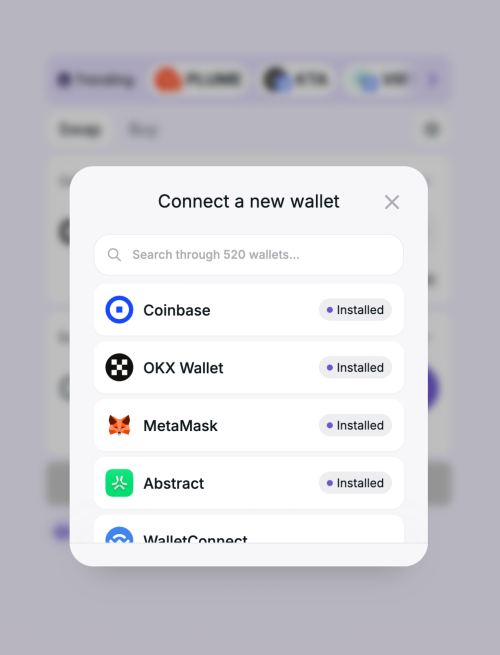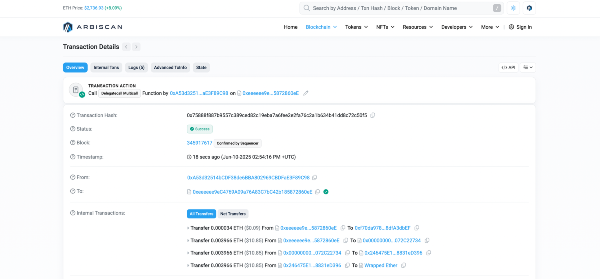How to Bridge to Arbitrum: Complete Guide [2025]
![How to Bridge to Arbitrum: Complete Guide [2025]](/content/images/size/w2000/2025/06/Arbitrum-1.png)
Looking to bridge to Arbitrum? You're in the right place. This guide covers every method to bridge your crypto assets to Arbitrum, from official bridges to third-party solutions like Relay. We'll compare costs, speeds, and security so you can choose the best option for your needs.
Introduction to Arbitrum
Arbitrum has become the go-to Ethereum Layer 2 for lower fees and faster transactions. Whether you're moving ETH, USDC, or other tokens, bridging to Arbitrum opens access to hundreds of DeFi protocols while dramatically reducing your transaction costs.
It was created by Offchain Labs to address Ethereum's scalability challenges, providing a robust solution for users seeking faster and more affordable transactions. As Ethereum network costs and congestion have increased, users frequently bridge their crypto assets to Layer 2 platforms like Arbitrum, enabling quicker and cheaper interactions with decentralized finance (DeFi) applications and smart contracts.
Arbitrum leverages optimistic rollup technology to achieve faster transaction processing and reduced fees, posting transaction summaries back to Ethereum while maintaining security. This approach significantly enhances scalability for the Ethereum network, supporting a broader ecosystem of decentralized applications and cross-chain interoperability.
Relay emerges as the best solution for seamlessly bridging assets through efficient cross-chain swaps. Supporting more than 80 blockchains, Relay simplifies the process of transferring tokens to Arbitrum with instant transactions, minimal fees, and an intuitive interface that makes cross-chain swaps accessible to both crypto beginners and advanced traders alike.
What Is Arbitrum?
Arbitrum is Ethereum’s popular Layer 2 scaling solution, designed to overcome the network’s challenges of high transaction costs and congestion. By using Arbitrum, users experience significantly lower fees than Ethereum Mainnet, ensuring cost-effective interactions for traders, investors, and developers alike. Additionally, transaction confirmations on Arbitrum are notably faster, enhancing user experience by dramatically reducing wait times. Arbitrum operates alongside the main Ethereum chain and enhances the scalability of the Ethereum blockchain, helping to reduce congestion and improve overall network efficiency.
Beyond its technical benefits, Arbitrum boasts a thriving ecosystem of decentralized apps (dApps). Its unique features include strong interoperability with other chains and support for a wide range of decentralized applications, enabling seamless asset transfers and integration across multiple blockchains. Users bridging assets to Arbitrum can immediately access various leading DeFi platforms, NFT marketplaces, and gaming applications, making it an ideal Layer 2 network for those seeking efficient and affordable blockchain transactions.
Why Use Relay for Bridging and Cross-Chain Swaps?

Relay significantly simplifies cross-chain swaps and bridging, enabling seamless transfers of crypto assets across different blockchain networks. Relay acts as a token bridge, ensuring compatibility and secure transfers between networks. Users can bridge asset pairs across different blockchains using Relay, making it easy to move and swap tokens between ecosystems.
The wide range of possibilities enabled by Relay's cross-chain bridging technology allows developers and users to explore extensive potential applications and integrations. With Relay, users can effortlessly bridge tokens to Arbitrum and numerous other chains, bypassing typical complexities associated with multi-chain transactions.
Key benefits that set Relay apart include:
- Instant transaction speed: Cross-chain swaps on Relay are near-instantaneous, eliminating lengthy waiting periods.
- Cost-effective bridging: Relay leverages optimized routes to keep bridging fees minimal compared to traditional bridging solutions.
- Extensive cross-chain support: Relay supports over 80 blockchain networks, making it a versatile choice for frequent multi-chain users.
- Easy-to-use interface: Relay’s intuitive platform is accessible and user-friendly, catering to both crypto newcomers and experienced traders navigating complex cross-chain ecosystems.
Token Compatibility and Bridging: What Can You Move to Arbitrum?
Token compatibility is a crucial factor when bridging assets from the Ethereum network to the Arbitrum network. Before initiating any transfer, it’s essential to ensure that the token you wish to bridge is supported on Arbitrum. The Arbitrum network is designed to be highly compatible with ERC-20 tokens, enabling users to move a wide variety of assets—including popular tokens like ETH, USDC, USDT, and many others—directly from Ethereum.
This broad token compatibility means users can seamlessly transfer their favorite assets, unlocking the full potential of decentralized finance on Arbitrum. To check if your token is supported, simply review the list of available tokens within your chosen bridge interface, such as Relay, before starting the process. If your asset is an ERC-20 token on the Ethereum network, it’s likely eligible for bridging to Arbitrum, but always verify to avoid any issues.
By ensuring token compatibility, users can confidently bridge assets, knowing their tokens will be recognized and usable on the Arbitrum network. This essential step enables a smooth, secure, and efficient transfer process, empowering users to fully participate in the expanding Arbitrum ecosystem.
Bridge Arbitrum: A Step-by-Step Tutorial

Step 1: Connect Your Wallet to Relay
Begin by visiting the Relay platform and establishing a secure connection between your cryptocurrency wallet and the platform. Relay supports various wallets, including popular options like MetaMask and WalletConnect, ensuring a secure and seamless cross-chain swap experience.

Step 2: Select Assets for Your Cross-Chain Swap
Next, choose the crypto assets you wish to bridge to Arbitrum. Relay supports popular tokens such as ETH, USDC, and USDT, making it simple for you to quickly initiate cross-chain swaps to Layer 2.
Choose Arbitrum as the Destination Network
On the Relay interface, select Arbitrum from the available destination networks. Simply click on the dropdown menu labeled “Destination Chain” and choose Arbitrum to set up your bridge.

Step 4: Confirm and Execute the Bridge
Review all transaction details carefully, noting Relay’s transparent display of bridging fees and security confirmations. Once satisfied, approve the transaction in your wallet interface—a prompt will appear requesting your confirmation. You must submit the transaction in your wallet to proceed. The transaction will then be processed and undergo verification before being finalized on Arbitrum.

Step 5: Verify Your Assets on Arbitrum
After bridging, use the Arbitrum Explorer to track the status of your transaction. Simply enter your wallet address or transaction hash to monitor the progress and check that your cross-chain swap to Arbitrum is marked as completed. Only consider the process complete once the transaction is confirmed as completed on the explorer.
Troubleshooting Common Arbitrum Bridge Issues
Transaction Stuck or Failed
If your bridge transaction fails, check:
- Sufficient ETH for gas fees on source chain
- Token contract address is correct
- Network isn't congested (check gas tracker)
Assets Not Appearing
After bridging to Arbitrum:
- Add Arbitrum network to your wallet
- Import the token contract address
- Check transaction on Arbiscan.io
High Bridge Fees
To reduce costs when bridging to Arbitrum:
- Bridge during low gas periods (weekends, late night UTC)
- Use larger amounts to amortize fixed costs
- Consider CEX withdrawals for significant savings
Wrong Network Selected
Double-check you're bridging to Arbitrum One (not Arbitrum Nova) unless specifically needed. Most DeFi protocols use Arbitrum One.
Bridge to Arbitrum: Frequently Asked Questions
How fast is Relay’s cross-chain swap to Arbitrum?
Relay’s cross-chain swap to Arbitrum is nearly instant, typically completing in under one minute. By leveraging an optimized routing system and native support for Arbitrum, Relay ensures fast confirmations with minimal user input—making it one of the fastest ways to bridge assets to Arbitrum.
What are the fees when bridging to Arbitrum using Relay?
When you bridge to Arbitrum using Relay, you benefit from low, transparent fees. Both gas fees and transaction fees are required when transferring assets between Ethereum and Arbitrum. Relay aggregates liquidity and optimizes gas usage across chains, often slashing swap and bridge costs by up to 70% compared to other platforms. Before starting the process, make sure to ensure sufficient ETH balance in your wallet to cover these fees. There are no hidden charges—just clear, upfront pricing before every transaction.
Is it possible to reverse a cross-chain swap transaction on Relay?
No, cross-chain swap transactions on Relay are irreversible once confirmed. Like most decentralized protocols, Relay operates on smart contracts, meaning that once the swap is executed and assets are bridged to Arbitrum (or any other chain), the transaction is final. Always double-check network, token, and wallet details before confirming.
What's the cheapest way to bridge to Arbitrum?
For amounts over $1,000, the official Arbitrum bridge typically offers the lowest fees. For smaller amounts or when you need speed, third-party bridges like Relay often provide better value when factoring in time savings.
Can I bridge any token to Arbitrum?
Most ERC-20 tokens can be bridged to Arbitrum, but check compatibility first. Popular tokens (ETH, USDC, USDT, WBTC) are widely supported across all bridge options.
Is it safe to bridge to Arbitrum?
Yes, Arbitrum is one of the most secure Layer 2 solutions. The official bridge is fully trustless, while reputable third-party bridges like Relay undergo regular security audits.
Best Practices for Secure Cross-Chain Bridging to Arbitrum
When using Relay to bridge assets cross-chain to Arbitrum, following these best practices helps ensure your transactions are safe and successful:
1. Prioritize Wallet Security
Use a reputable wallet like MetaMask or WalletConnect and ensure it’s updated to the latest version.
Enable two-factor authentication where available, and never share your private keys or recovery phrases. For extra protection, consider using a hardware wallet when bridging large amounts to Arbitrum.
Always securely back up your seed phrase during wallet setup, as it is essential for wallet recovery and protecting your assets.
2. Always Verify Transaction Details
Before confirming a cross-chain swap or bridge to Arbitrum, double-check:
- The destination wallet address
- The amount and token selected
- The destination network (Arbitrum)
- The transaction data to ensure all details are correct and secure
Relay’s interface displays all these details clearly before you approve the transaction.
3. Confirm You’re Using the Official Relay Platform
Phishing sites can mimic popular dApps. Make sure you’re using the official Relay link (https://www.relay.link) when initiating a bridge. Bookmark the site to avoid mistakes.
4. Monitor Transaction Completion
After bridging, use the Arbitrum Explorer to verify the transaction has successfully reached your wallet. Relay often provides a link directly to the explorer for convenience.
By following these steps, you can safely bridge crypto to Arbitrum using Relay with confidence and peace of mind.
Bridging to Arbitrum also enables you to access a wide range of DeFi protocols, including decentralized exchanges, lending platforms, and other services within the Arbitrum ecosystem.
Exploring Arbitrum’s Ecosystem After Bridging
Once you’ve successfully bridged assets to Arbitrum using Relay, you unlock access to a rapidly growing Arbitrum ecosystem packed with high-performance DeFi applications.
Here are some of the most popular Arbitrum DeFi apps to explore:
- Uniswap (v3 on Arbitrum) – The iconic DEX is fully integrated with Arbitrum, offering faster and cheaper swaps than Ethereum mainnet.
- Radiant Capital – A cross-chain lending protocol that lets users borrow and lend assets across chains while earning yield.
- Dopex – A decentralized options platform offering innovative strategies for hedging and yield generation.
- TreasureDAO – A gamified NFT and DeFi hub that combines gaming economies with DeFi mechanics.
The Arbitrum ecosystem continues to expand, making it a prime destination for users seeking low-cost, high-speed DeFi. Whether you're trading, lending, or yield farming, Arbitrum offers a seamless experience for onchain activity after bridging.
Conclusion
If you’re looking to bridge to Arbitrum quickly, affordably, and securely, Relay is the optimal choice. With support for cross-chain swaps across 80+ networks, Relay offers a seamless way to move assets into the Arbitrum ecosystem—all through an easy-to-use interface designed for both beginners and pros.
Relay stands out with its instant transaction speed, cost-effective bridging, and commitment to wallet security and transaction transparency. Whether you’re exploring popular Arbitrum DeFi apps or simply seeking a faster way to get onchain, Relay simplifies every step of the process.
Choose Relay for your next cross-chain bridge to Arbitrum—and experience a faster, smarter way to swap.

